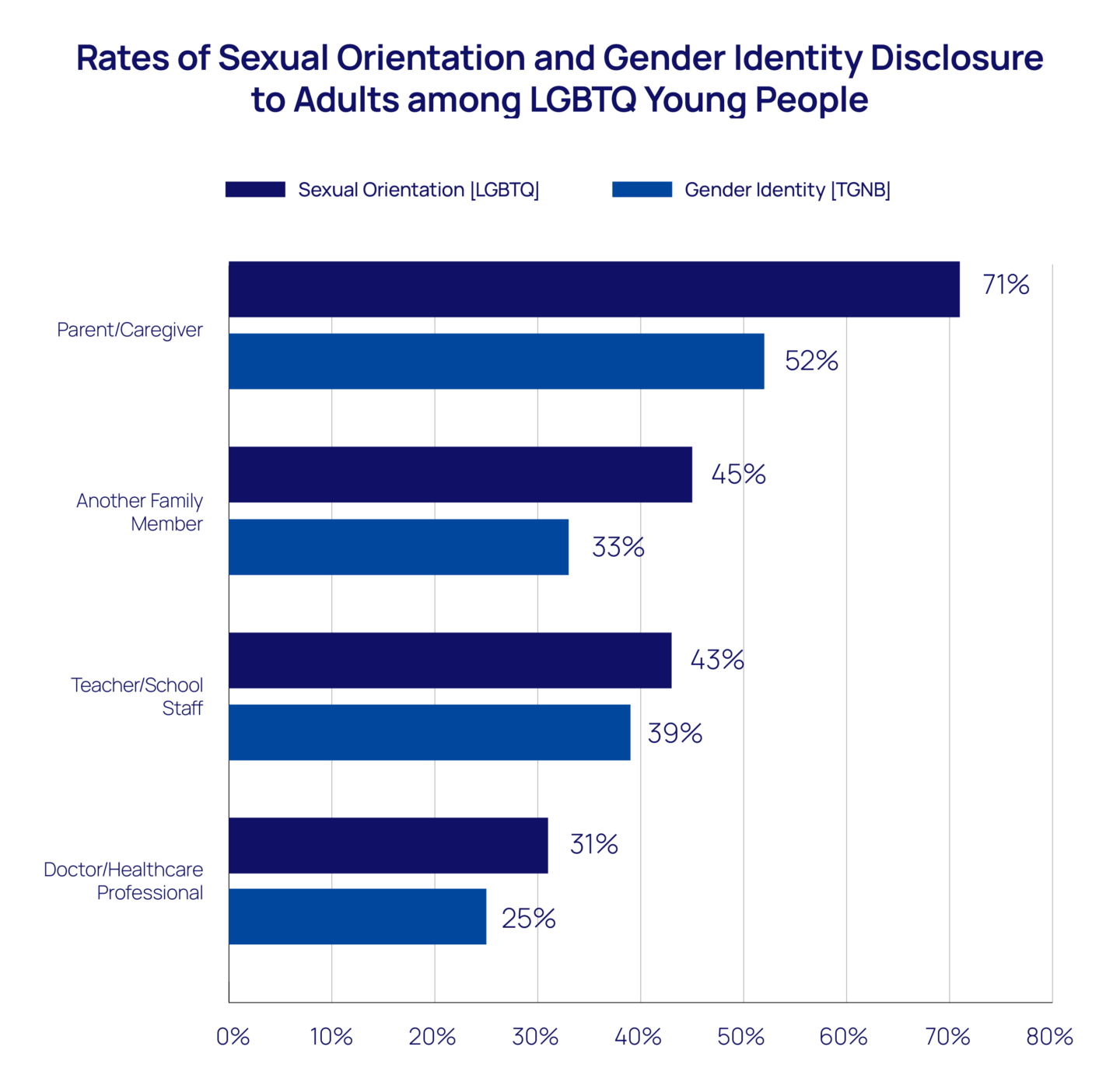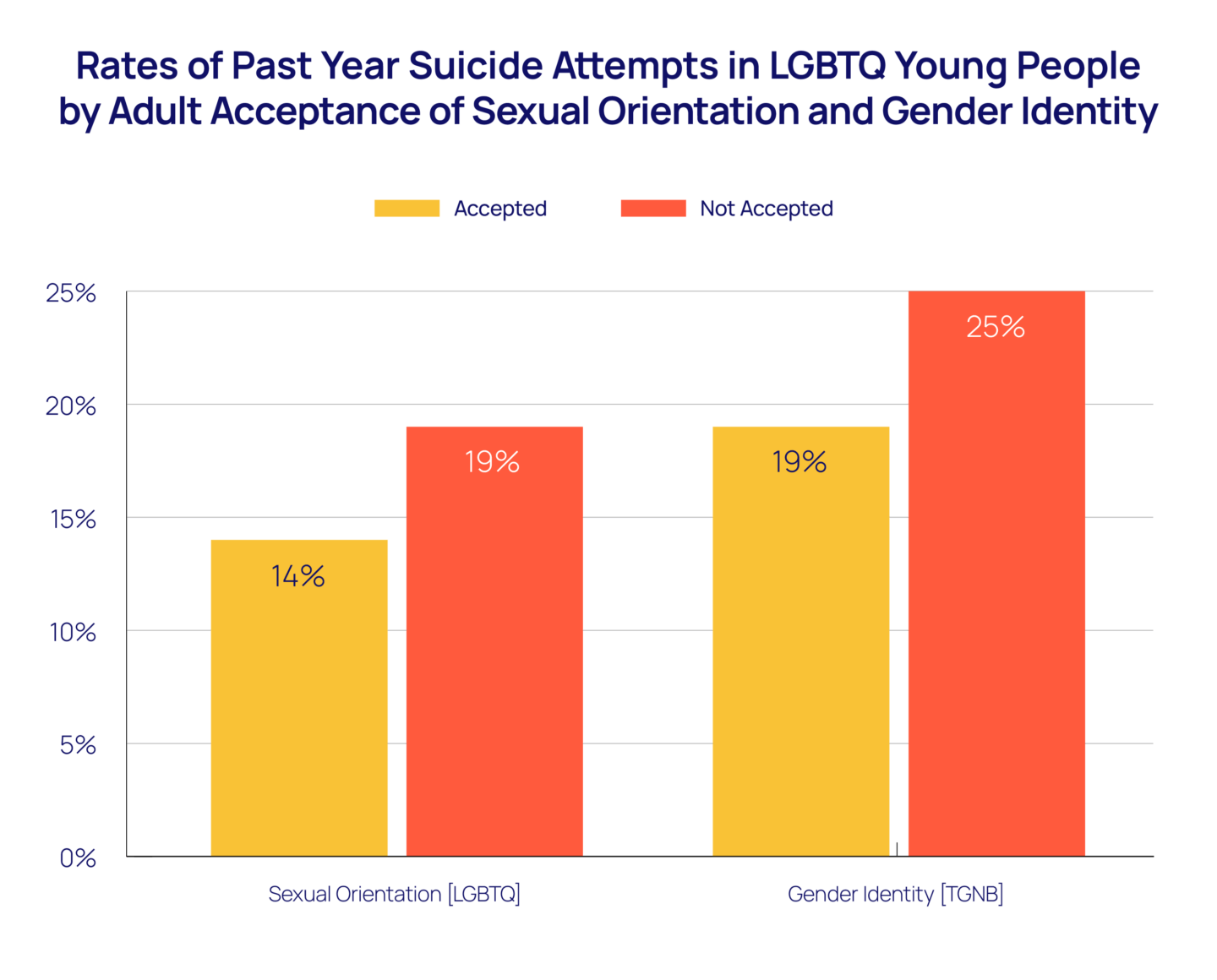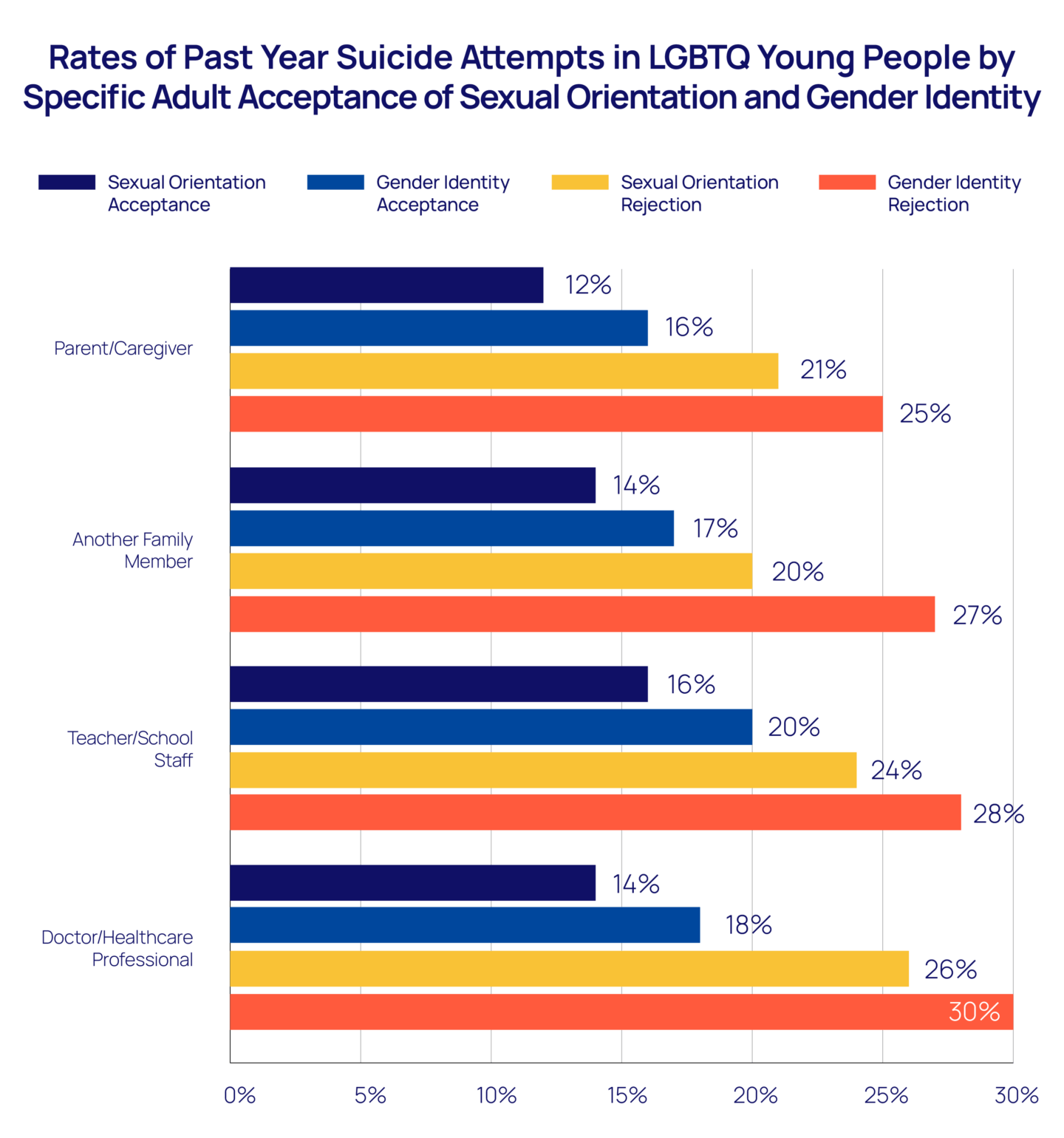Background
LGBTQ young people are more likely to report mental health concerns, such as depression, anxiety, and suicidality, in comparison to their straight and cisgender peers (Johns et al., 2019; Johns et al., 2020). It is well-documented that receiving LGBTQ identity-related support and acceptance from others may help protect against the development of these mental health concerns, with prior research from The Trevor Project showing that sexual orientation and gender identity acceptance from an adult is related to lower rates of suicide attempts among LGBTQ young people (Green, Price-Feeney, & Dorison, 2021; Price & Green, 2023; The Trevor Project, 2019). More specifically, this research documented that LGBTQ young people who felt their sexual orientation was accepted by at least one adult, and transgender and nonbinary (TGNB) young people who felt their gender identity was accepted by at least one adult, had lower odds of reporting a suicide attempt in the past year compared to those who did not feel accepted. Similar findings have been found in longitudinal work, suggesting possible causal effects between perceived support and suicide attempts in LGBTQ young people (Mustanski et al., 2013). This brief will expand upon our previous work by examining differences in identity disclosure and acceptance, as well as explore the relationship between identity acceptance from specific adults and suicide attempts among LGBTQ young people, using new data from The Trevor Project’s 2023 National Survey on the Mental Health of LGBTQ Young People.
Results

LGBTQ young people were more likely to disclose their sexual orientation to adults than their gender identity. In the overall sample, 71% reported disclosing their sexual orientation to a parent/caregiver, compared to 52% of TGNB young people who disclosed their gender identity. Similarly, 45% disclosed their sexual orientation to another family member compared to 33% of TGNB young people who disclosed their gender identity, 43% disclosed to a teacher/school staff (versus 39% for gender identity), and 31% to a doctor/healthcare professional (versus 25% for gender identity). Regarding identity disclosure to any of these adults, the vast majority (82%) of LGBTQ young people reported that they disclosed their sexual orientation to at least one adult, compared to 64% of TGNB young people who disclosed their gender identity to at least one adult.

Adults were less likely to accept a TGNB young person’s gender identity compared to an LGBTQ young person’s sexual orientation. Among LGBTQ young people who disclosed their sexual orientation to an adult, almost 9 in 10 (88%) reported that at least one adult was accepting of their sexual orientation. Of those without an accepting adult, nearly 19% reported a suicide attempt in the past year, compared to 14% with at least one accepting adult. Among TGNB young people who disclosed their gender identity to an adult, nearly 8 in 10 (79%) reported that at least one adult was accepting of their gender identity. Nearly 25% of those without an accepting adult reported a suicide attempt in the past year, compared to 19% of those with at least one accepting adult.
Both LGBTQ and TGNB young people who were out and felt their sexual orientation (aOR=0.59, p<.001, CI=.54-.64) or gender identity (aOR=0.60, p<.001, CI=0.53-0.67) was accepted by a parent/caregiver had around 40% lower odds of attempting suicide in the past year compared to young people who were out to a parent/caregiver and did not feel accepted. These results were similar with other adults, as well. For example, LGBTQ and TGNB young people both had 45% lower odds of a past year suicide attempt if they felt their sexual orientation (aOR = 0.55, p<.001, CI=0.46-0.65) or gender identity (aOR=0.55, p<.001, CI=0.46-0.67) was accepted by their doctor. When LGBTQ young people reported that teachers were accepting, they had 43% lower odds of a past year suicide attempt (sexual orientation; aOR=0.57, p<.001, CI=0.48-0.67) and TGNB young people had 35% lower odds (gender identity; aOR=.65, p<.001, CI=0.55-0.77), compared to their peers who did not report this acceptance. Finally, if they felt accepted by another family member (not a sibling), LGBTQ young people had 33% lower odds of a past year suicide attempt (sexual orientation; aOR=0.67, p<.001, CI=0.60-0.75) and TGNB young people had 43% lower odds (gender identity; aOR = 0.57, p<.001, CI=0.49-0.66), compared to their peers who did not report this acceptance. It is of note that to be included in these analyses, participants had to be out to the specific adult in each separate analysis.
For specific rates of suicide attempts in each group, please see the chart below. Suicide rates were significantly different between those who were out and felt accepted versus those who were out and did not feel accepted for both their sexual orientation (LGBTQ young people) and gender identity (TGNB young people) across all adult groups.

LGBTQ young people who reported sharing their sexual orientation with at least one of the four examined adults, and feeling accepted by at least one of these adults, had 24% lower odds of reporting a suicide attempt in the past year (aOR=0.76, p<.001, CI=0.68-0.86) compared to LGBTQ young people who were out to at least one adult but did not feel accepted. Similarly, TGNB young people who reported sharing their gender identity and being accepted by at least one of the four adults examined had 30% lower odds of reporting a suicide attempt in the past year (aOR=0.70, p<.001, CI=0.63-0.79) compared to TGNB youth who were out to at least one adult and not accepted.
Methods
Data were collected through The Trevor Project’s 2023 U.S. National Survey on the Mental Health of LGBTQ Young People. In total, 28,524 LGBTQ young people between the ages of 13-24 were recruited via targeted ads on social media. For analyses with TGNB young people, 18,378 (64.4%) of the sample identified as transgender or nonbinary and were included. Young people were separately asked to what degree adults (i.e., parents/caregivers, other family members [does not include siblings], teachers/school staff, and doctors/healthcare providers) accepted their sexual orientation and gender identity (only asked to TGNB young people) with response options including: “Not applicable/I do not have this person in my life”, “I am not out to this person/these people,” “Extremely accepting,” “Quite a bit accepting,” “Moderately accepting,” “A little bit accepting,” and “Not at all accepting.” Responses were dichotomized such that adults that were “Moderately,” “Quite a bit” or “Extremely” accepting were considered “accepting” and those that were “A little bit” or “Not at all” accepting were considered “not accepting.” It is notable that to be included in the isolated adult analyses (e.g., parents/caregivers), participants had to be out to that specific adult. Further, for the “at least one” analyses, participants must have been out to at least one of the examined adults to be included. The question assessing past-year suicidality was taken from the Centers for Disease Control and Prevention’s Youth Risk Behavior Survey (Johns et al., 2020). Chi-square tests were used to examine differences between groups. All reported comparisons are statistically significant at least at p<0.05. This means there is less than a 5% likelihood these results occurred by chance. Adjusted logistic regression models were run to determine the association between feeling accepted and having a suicide attempt in the past year, controlling for race, age, sexual orientation, assigned sex, and gender identity.
Looking Ahead
This research brief extends and expands upon prior work published by The Trevor Project. These updated findings suggest that adult acceptance of a young person’s sexual orientation or gender identity continues to be associated with lower odds of past-year suicide attempts for LGBTQ young people. We also found that TGNB young people were less likely to disclose and feel accepted by adults for their gender identity compared to their LGBTQ peers who disclose their sexual orientation. Lower rates of gender identity acceptance among TGNB young people were also associated with higher rates of past-year suicide attempts.
In contrast to experiencing rejection related to one’s identity, which can contribute to the development of minority stress and poor mental health outcomes (Meyer, 2003), feeling accepted is associated with positive mental health outcomes. Being accepted by an adult could be life-saving for LGBTQ young people (Green, Price-Feeney, & Dorison, 2021; Mustanski & Liu, 2013; Price & Green, 2023; The Trevor Project, 2019). Adult acceptance may be especially important for TGNB young people, given their increased hesitancy to disclose their gender identity to adults, possibly due to a greater possibility of rejection, as documented above. Lower rates of gender identity disclosure and adult identity acceptance among TGNB young people may also be impacted by the current wave of anti-transgender legislation and rhetoric in the American political landscape (see The Trevor Project’s LGBTQ Legislation Heatmap). It is essential that all adults who have contact with LGBTQ young people, including parents/caregivers, other family members, teachers, healthcare providers, and others, work towards being supportive and accepting of LGBTQ young people to positively impact their health and development.
Future research should be longitudinal in nature whenever possible in order to identify more causal mechanisms, especially with large sample sizes, which can help to further support generalizing findings. Additionally, this work should continue to explore how adults can best support LGBTQ young people. We urge all adults to consider ways to support and practice acceptance of LGBTQ young people in their lives, especially by seeking out additional education and training on how to be an ally. Some resources through the Trevor Project’s Resource Center include: The Guide to Being an Ally to Transgender and Nonbinary Young People, Understanding Gender Identities, How to Support Bisexual Youth, and Understanding Asexuality.
At The Trevor Project, our Crisis Services team works 24/7 to be a supportive and accepting adult for LGBTQ young people in crisis. We also provide training for adults, including professionals who work with young people (e.g., counselors, educators, school nurses, social workers, and other adults), as a means to increase acceptance of LGBTQ identities and understanding of their unique needs, as well as provide guidance on LGBTQ-competent and trauma-informed suicide prevention efforts. Additionally, Trevor’s Research team is committed to the ongoing dissemination of research that allows everyone to better support and accept LGBTQ young people.
Recommended Citation: The Trevor Project. (2023). Acceptance from adults is associated with lower rates of suicide attempts among LGBTQ young people.
References
- Green, A. E., Price-Feeney, M., & Dorison, S. H. (2021). Association of sexual orientation acceptance with reduced suicide attempts among lesbian, gay, bisexual, transgender, queer, and questioning youth. LGBT Health, 8(1), 26-31.
- Johns, M. M., Lowry, R., Andrzejewski, J., Barrios, L. C., Demissie, Z., McManus, T., Rasberry, C. N., Robin, L., & Underwood, J. M. (2019). Transgender identity and experiences of violence victimization, substance use, suicide risk, and sexual risk behaviors among high school students—19 States and large urban school districts, 2017. MMWR. Morbidity and Mortality Weekly Report, 68(3), 67–71. DOI: 10.15585/mmwr.mm6803a3
- Johns, M. M., Lowry, R. R., Haderxhanaj, L. T., Rasberry, C., Robin, L., Scales, L., Stone, D., Suarez, N., & Underwood, J. M. (2020). Trends in violence victimization and suicide risk by sexual identity among high school students — youth risk behavior survey, United States, 2015–2019. MMWR Morbidity Mortality Weekly Report, 69(Suppl-1), 19–27. DOI: 10.15585/mmwr.su6901a3external
- Meyer, I. H. (2003). Prejudice, social stress, and mental health in lesbian, gay, and bisexual populations: Conceptual issues and research evidence. Psychological Bulletin, 129(5), 674–697. DOI: 10.1037/0033-2909.129.5.674
- Mustanski, B., & Liu, R. T. (2013). A longitudinal study of predictors of suicide attempts among lesbian, gay, bisexual, and transgender youth. Archives of Sexual Behavior, 42, 437-448.
- Price, M. N., & Green, A. E. (2023). Association of gender identity acceptance with fewer suicide attempts among transgender and nonbinary youth. Transgender Health, 8(1), 56-63.
- The Trevor Project (2019). Accepting adults reduce suicide attempts among LGBTQ youth.
- The Trevor Project (2023). 2023 U.S. national survey on the mental health of LGBTQ young people. [Data set].
For more information please contact: [email protected]